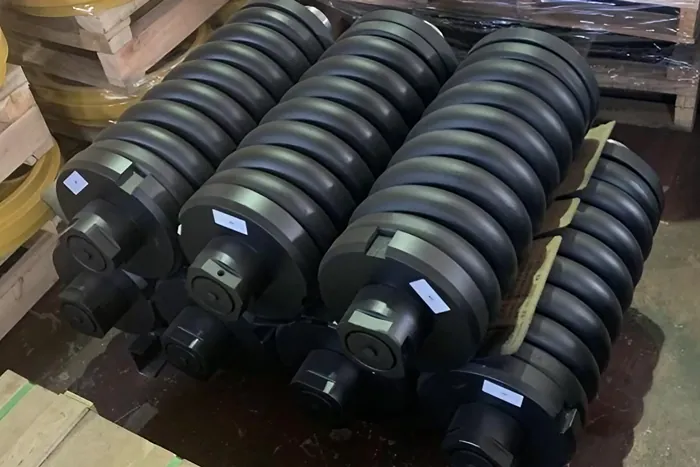Excavator Track Tightness Adjustment Guide

The tightness of an excavator's tracks is like the fit of a person's shoes, which must be adjusted to the optimum condition to ensure the efficient operation of the machine. In the process of traveling, the excavator will often lead to changes in the elasticity of the tracks, and the elasticity of the tracks directly affects the degree of wear of the chain and contact fittings. Therefore, adjusting the track looseness of the excavator is a must for the operator.
Importance of Track Tightness
The ‘four wheels and one belt’ on the lower frame of the excavator include the tensioning wheel, supporting wheel, supporting chain wheel, driving wheel, and track. In using different Excavators, some need to replace the carrier wheel and supporting wheel frequently, while some can be used for a long time, which is closely related to the tightness of the track. Therefore, the flexible adjustment of track tightness under different working conditions is the key to correctly using the excavator.
Principle of track adjustment
Adjust the tracks slightly tighter when working on hard ground.
When working on hard ground, the track should be adjusted slightly tighter to avoid collision with the lower frame caused by too loose track, which will lead to wear.
Adjust the tracks slightly looser when working on soft ground.
It is better to adjust the tracks a little looser when working on soft ground. Under these conditions, the chain links and tracks are prone to soil adhesion, and appropriate loosening can reduce the abnormal pressure generated by soil on the chain links.
Avoid over-tightening or over-loosening the tracks.
When adjusting track tightness, be sure to keep it moderate. Over-tightening the tracks will affect traveling speed and power, and increase wear and tear on all components; over-loosening the tracks will cause severe wear and tear on the drive and trailing sprockets.
Note: Many people overlook an important point: when the tracks are loose and sag excessively, they may come into contact with the frame and wear it out. Therefore, it is important to get the exact tightness when adjusting, otherwise failure is inevitable.
Criteria for track tensioning
The criteria for adjusting the track tension of the excavator are as follows:
Rotate the excavator to one side so that one side of the track is off the ground.
Measure the furthest distance between the lower carriage and the chain, the standard range is 320 mm-340 mm.
Introduction of the tensioning device
The track elasticity cannot be adjusted without the tensioning device. The tensioning device is installed at the front end of the lower frame and mainly includes:
Main tensioning cylinder: located inside the frame, connecting with the tensioning wheel at the front and closely matching with the chain.
Grease filling port: located on the side of the frame, used to add grease to lubricate the tensioning cylinder.
maintenance of tensioning cylinder
Many people think that as long as the track tension is appropriate, the tensioning cylinder needs no maintenance, which is wrong. Unlike other cylinders on the excavator, the rod of the tensioning cylinder has a small expansion and contraction range when working and is exposed to the air for a long time, which is susceptible to dust and mud erosion, leading to corrosion and surface damage.
Maintenance steps:
Loosen the cylinder grease nipple 1-2 turns to discharge the grease in the cylinder barrel and retract the cylinder rod.
Tighten the grease nipple and add new grease.
Check the surface of the cylinder rod for any abnormalities and apply grease if necessary.
Tensioning cylinder failure phenomenon
The most common failure of the tensioning cylinder is that new grease cannot enter and old grease cannot be discharged. This is usually due to the cylinder rod surface and the cylinder head oil seal jamming, resulting in the cylinder rod can not move, while the cylinder grease fluidity is poor, affecting the sealing performance. Dealing with this kind of failure is more complicated, one usually needs to use a jack to jack out the cylinder for repair.
Adjusting the tightness of the excavator tracks must be operated by the standard to effectively protect the ‘four wheels and one belt’. In addition, do not neglect the regular maintenance of the tensioning cylinder, the device directly affects the tightness of the tracks and is easy to jam, so you need to always pay attention to its condition to ensure the normal operation of the excavator.
Why Choose SAIVS™ as Your Supplier?
Committed to innovation and customer needs, SAIVS specializes in high-quality machinery components for diverse industries like construction, mining, and agriculture. They offer a wide range of parts, including undercarriage components for popular brands, ensuring optimal performance and durability. values customer satisfaction, providing competitive prices, fast shipping, and exceptional service to keep your operations running smoothly.